Permanent Mold Castings
This page will cover a range of permanent mold casting topics, including:
-
The unique characteristics of permanent mold castings.
-
The permanent mold casting process.
-
Examples of permanent mold castings.
-
Applications and uses of permanent mold casting.
-
And much more insightful information.
Core Traits of Permanent Mold Castings
Permanent mold castings, also known as gravity die castings, refer to a metal casting process that employs reusable molds. They are usually made from metals like steel or iron. Unlike disposable molds used in sand casting and lost wax casting, these molds are designed to be used repeatedly for the production of multiple castings.
Key characteristics and aspects of permanent mold casting include:
-
Material of Molds: The molds are typically made of metals with high heat resistance and durability, such as steel or cast iron. These materials can withstand the thermal stress of repeated casting cycles without significantly degrading.
-
Process: Molten metal, commonly aluminum, magnesium, or copper-based alloys, is poured into the mold cavity. The metal fills the mold under the force of gravity, without the need for additional pressure (as in die casting).
-
Reusability: One of the most significant advantages of permanent mold casting is the reusability of the molds. These molds can be used to produce many castings, making the process more efficient and cost-effective for high-volume production.
-
Quality of Castings: Castings produced in permanent molds generally have a good surface finish and more consistent mechanical properties compared to those made in expendable molds. The metal cools and solidifies quicker in metal molds, leading to finer grain structures and enhanced strength in the final product.
-
Applications: This casting method is widely used for manufacturing parts that require higher strength, ductility, and better surface finish than those produced through sand casting. It is particularly popular in automotive, aerospace, and various industrial applications.
The Permanent Mold Casting Process and Advantages
In permanent mold casting, the molds are critical components that significantly influence the tolerance levels of the final cast product. It's essential that every step in this process is executed in order and with attention to detail to ensure the end product aligns with the specified design parameters, standards, and tolerances.
"Permanent mold casting" is a broad term encompassing various methods that utilize permanent molds for casting parts. Each of these methods involves the insertion of molten metal into a mold, with the specific technique of insertion varying based on the process and the intended result.
The major types of permanent mold casting include:
-
Gravity casting
-
Low-pressure casting
-
Vacuum casting
-
Slush casting
The molds are crafted from metals resistant to fatigue, such as iron, steel, bronze, graphite, or copper-based alloys. These materials are selected for their capacity to endure repeated exposure to molten metal. Permanent casting molds can be constructed in multiple sections, depending on the complexity of detail in the part being cast.
Creating a permanent mold casting starts with designing a pattern for the item to be cast. This pattern includes gates and sprues, which are critical for directing the flow of the molten metal. As permanent molds are typically made in two halves, these gates and sprues are strategically positioned to guarantee complete and uniform coverage of molten metal throughout the mold.
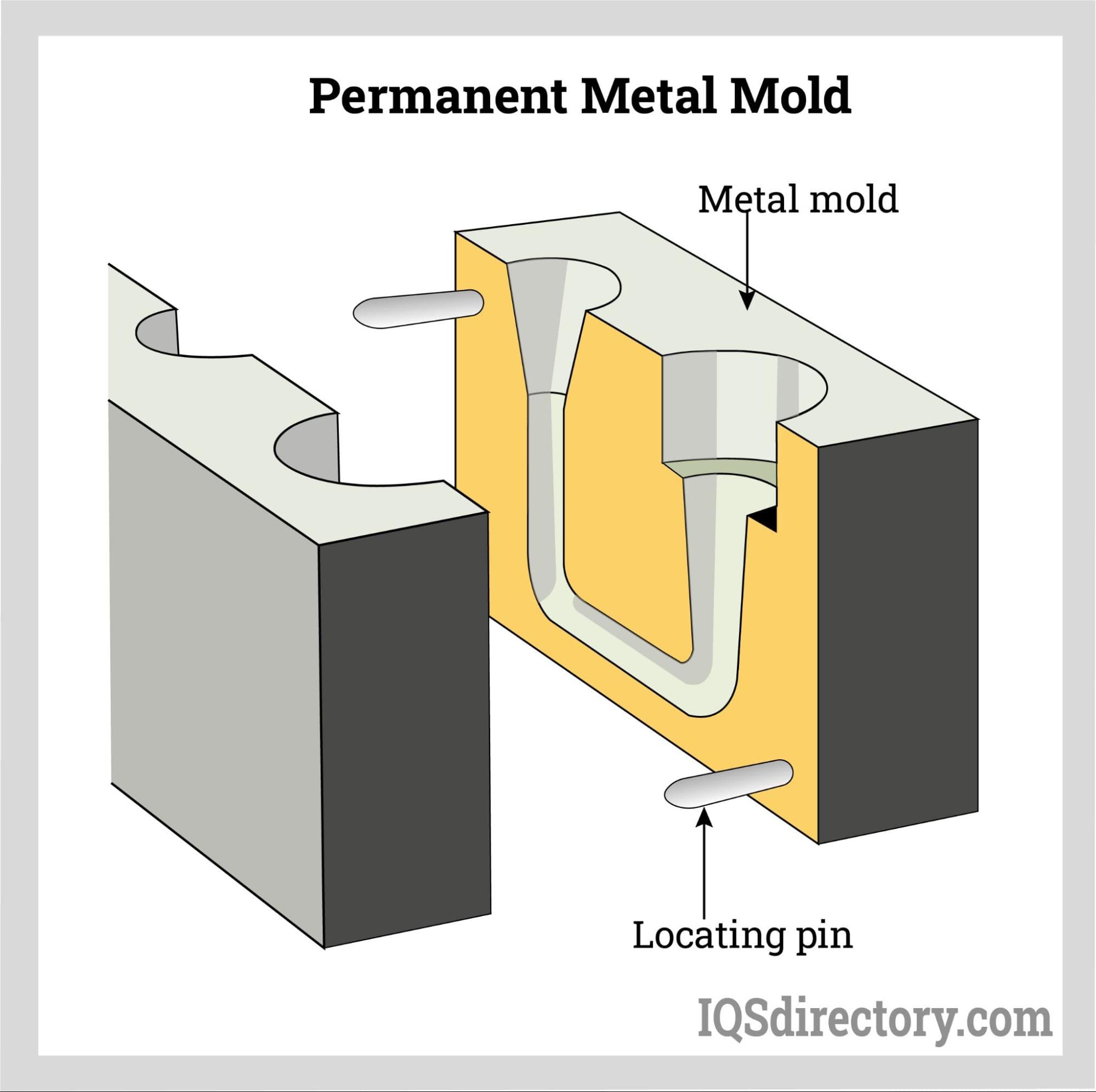
Each mold is essentially a negative imprint of the final cast shape, precisely replicating the original pattern. Consequently, all castings from this mold are exact copies of the pattern. Permanent molds offer advantages over temporary molds, such as reduced porosity due to the solid and smooth nature of materials like steel or iron. This feature is crucial for enhancing the strength of the casting. Furthermore, the thickness of the mold walls helps in evenly distributing stress, thereby bolstering the casting's strength.
A mold, once created, is capable of being used thousands of times, with its lifespan influenced by factors like temperature, mold material, and the types of metals cast.
Permanent mold castings offer the following advantages over traditional castings:
-
Permanent mold casting stands out for having the least shrinkage.
-
Permanent mold castings retain an excellent surface finish.
-
Permanent mold casting significantly reduces waste and scrap.
Types of Permanent Mold Castings
There are primarily four main categories: gravity casting, slush casting, low pressure casting, and vacuum casting. Each of these types differs in the method by which molten metal is introduced into the permanent mold. We’ll explain each of these in detail below.
There are some common elements across all types of permanent mold castings. These include the use of a mold (usually made in two halves), the process of inserting molten metal into these molds, and the overall principle of employing a permanent, reusable mold. This shared foundation underlies the specific techniques that characterize each casting type.
An integral aspect of mold design includes guide, alignment, or locating pins. These are essential for precisely positioning the mold halves. Positioned on one half of the mold, they align with corresponding holes on the other half. Ensuring accurate alignment of the mold halves is crucial for achieving the desired tolerance in the casting, which is the primary purpose of these locating pins.
Gravity Casting
Gravity casting permanent molds stands as the most traditional method of permanent mold casting. As the name suggests, the molten metal is introduced into the mold using gravity. The metal is either poured straight into the mold or as the mold is gradually tilted.
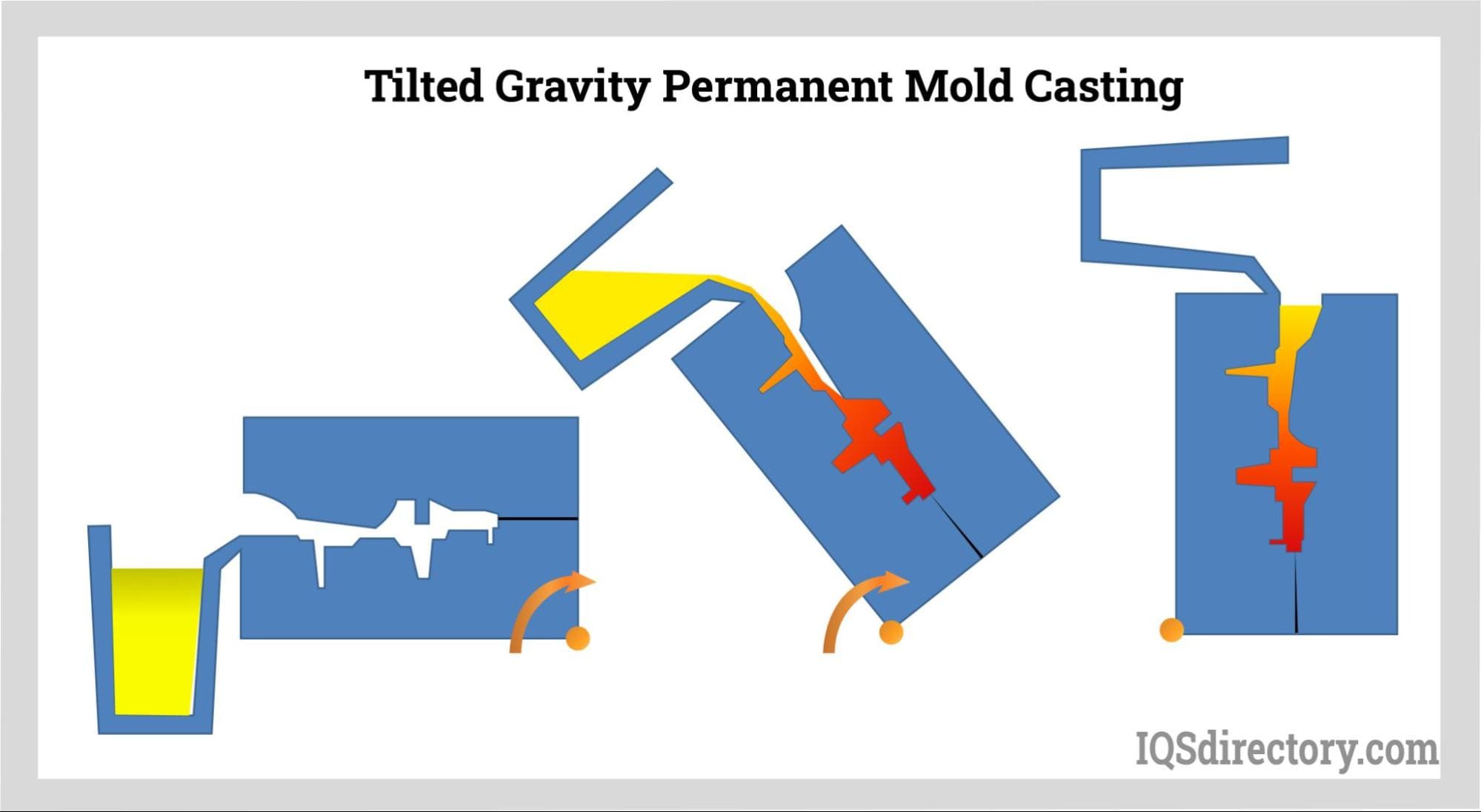
This ensures that the mold's cavity is uniformly filled by guiding the molten metal through a series of channels, known as a gating system, and into the mold's sprues (the passages leading to the main cavity).
Low-pressure Casting
Low pressure permanent mold casting operates distinctly from gravity casting, utilizing a controlled low pressure range between 3 to 15 psi. This pressure is applied to a reservoir of molten metal situated beneath the mold, unlike gravity casting where the metal is simply poured into a tilted mold. The gradual increase in pressure propels the molten metal upward through channels, known as risers, filling the mold cavity uniformly.
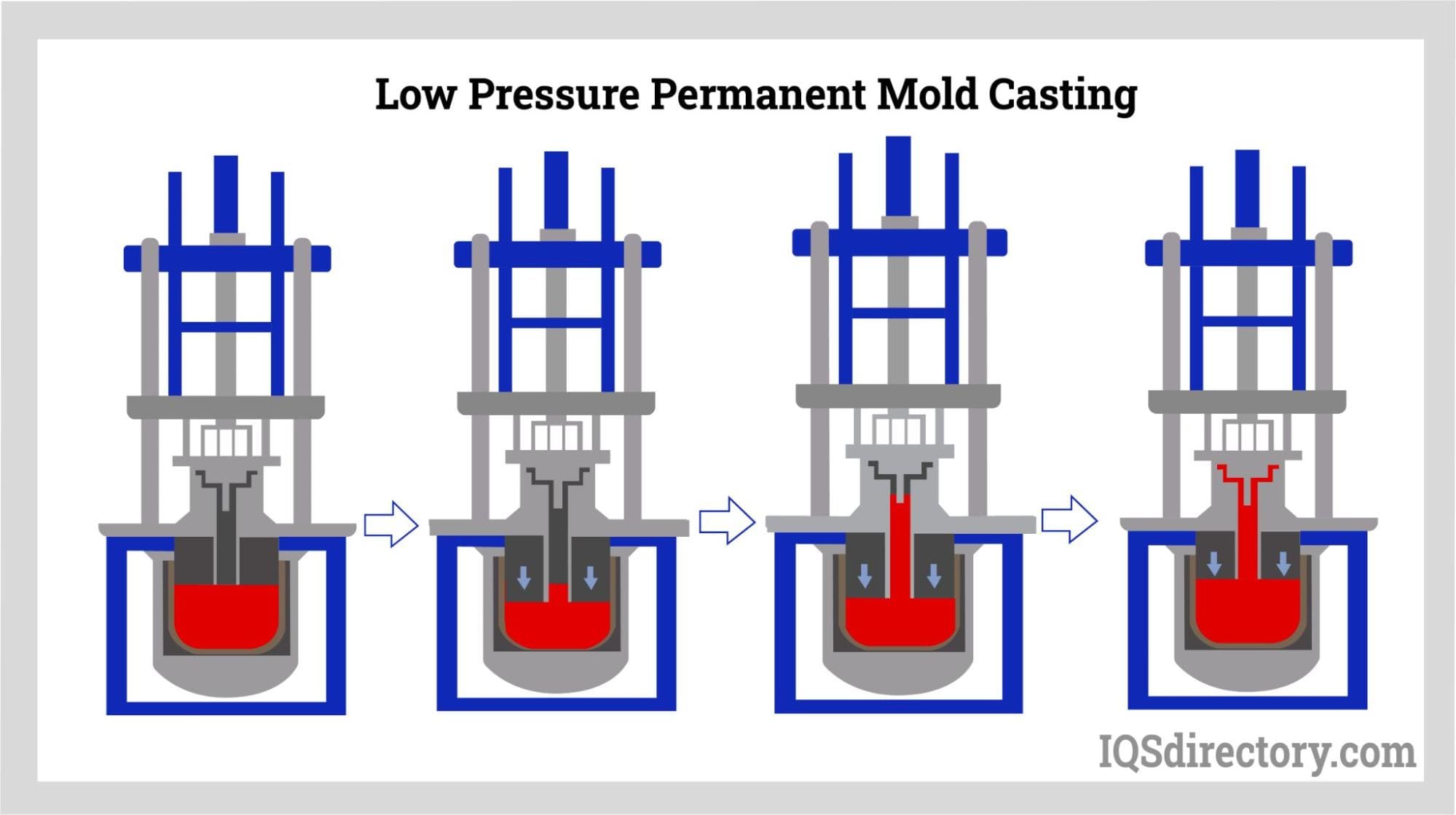
Throughout this process, the applied pressure is carefully maintained until the metal solidifies within the mold. Once solidification is complete, the pressure is eased, allowing any excess molten metal in the risers and mold to flow back into the reservoir. This controlled pressure application is key to achieving a consistent and thorough fill of the mold. It minimizes porosity and oxide formation by ensuring a smooth metal flow from the bottom to the top of the mold. The result of this process is the production of castings characterized by high density, strength, and precise dimensional accuracy.
Vacuum Casting
Vacuum casting shares similarities with low-pressure casting, since the molten metal is also positioned below the mold and connected to it through a network of risers and gates. The mold, held above the reservoir of molten metal, is often manipulated using a robotic arm for precise stability control. By reducing the pressure inside the mold, the metal is effectively drawn upwards through the risers and gates, filling the mold cavity.
With vacuum casting, the number of gas defects in the final mold are greatly reduced. This is because the air is removed through the vacuum casting process.
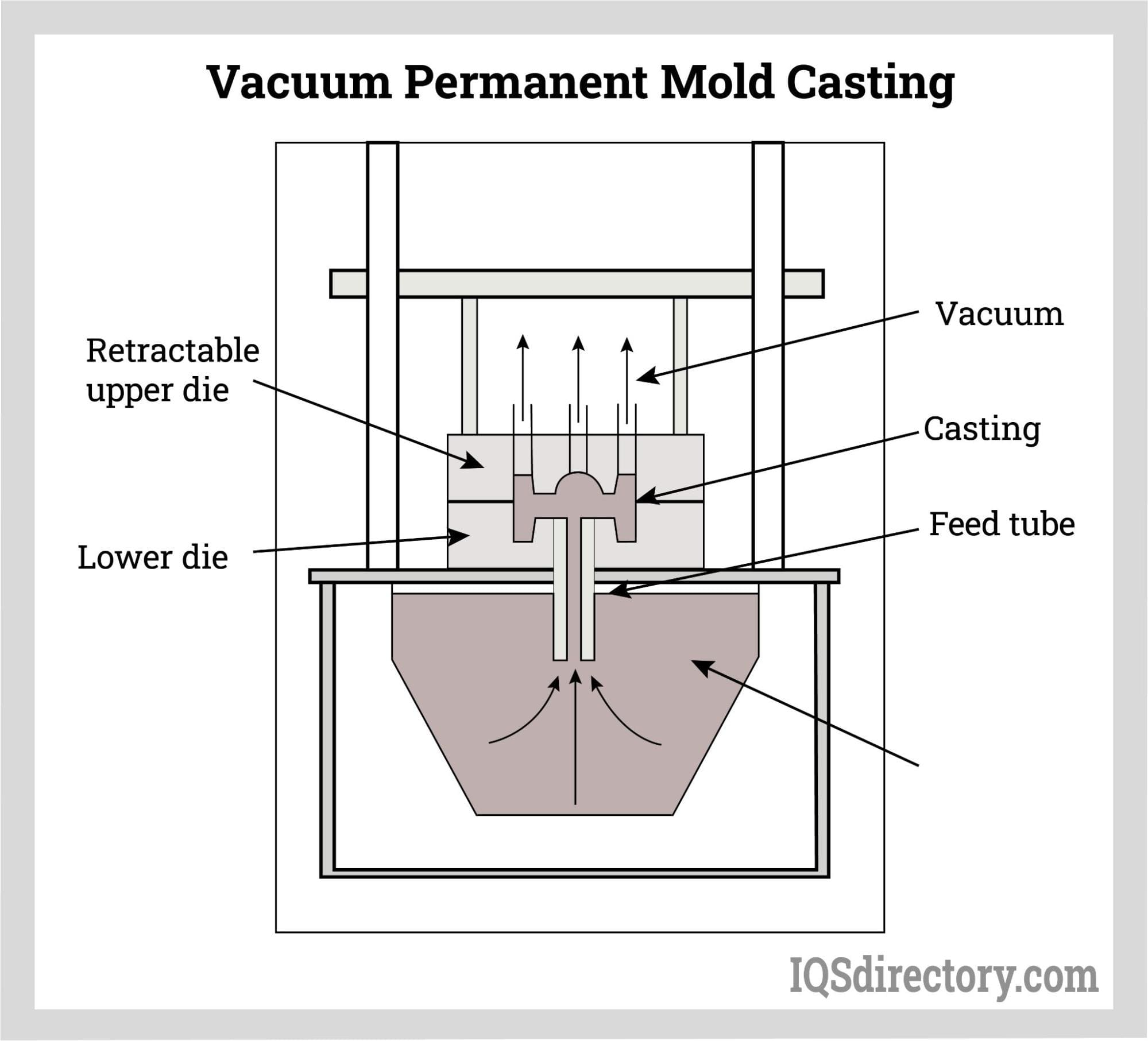
Once the metal solidifies, the mold is retracted from the reservoir, enabling the removal of the solidified casting. Vacuum permanent mold casting is widely utilized for its ability to achieve high precision, surface quality, and superior mechanical characteristics. This method is particularly well-suited for producing castings with thin walls; a challenge in comparison to other casting techniques.
Slush casting
Slush permanent mold casting is primarily for producing hollow castings. This method, while not offering precise control over the casting's geometry and strength, follows the general steps common to all permanent mold casting processes. These include heating the mold, securing it with clamps, and pouring in the molten metal.
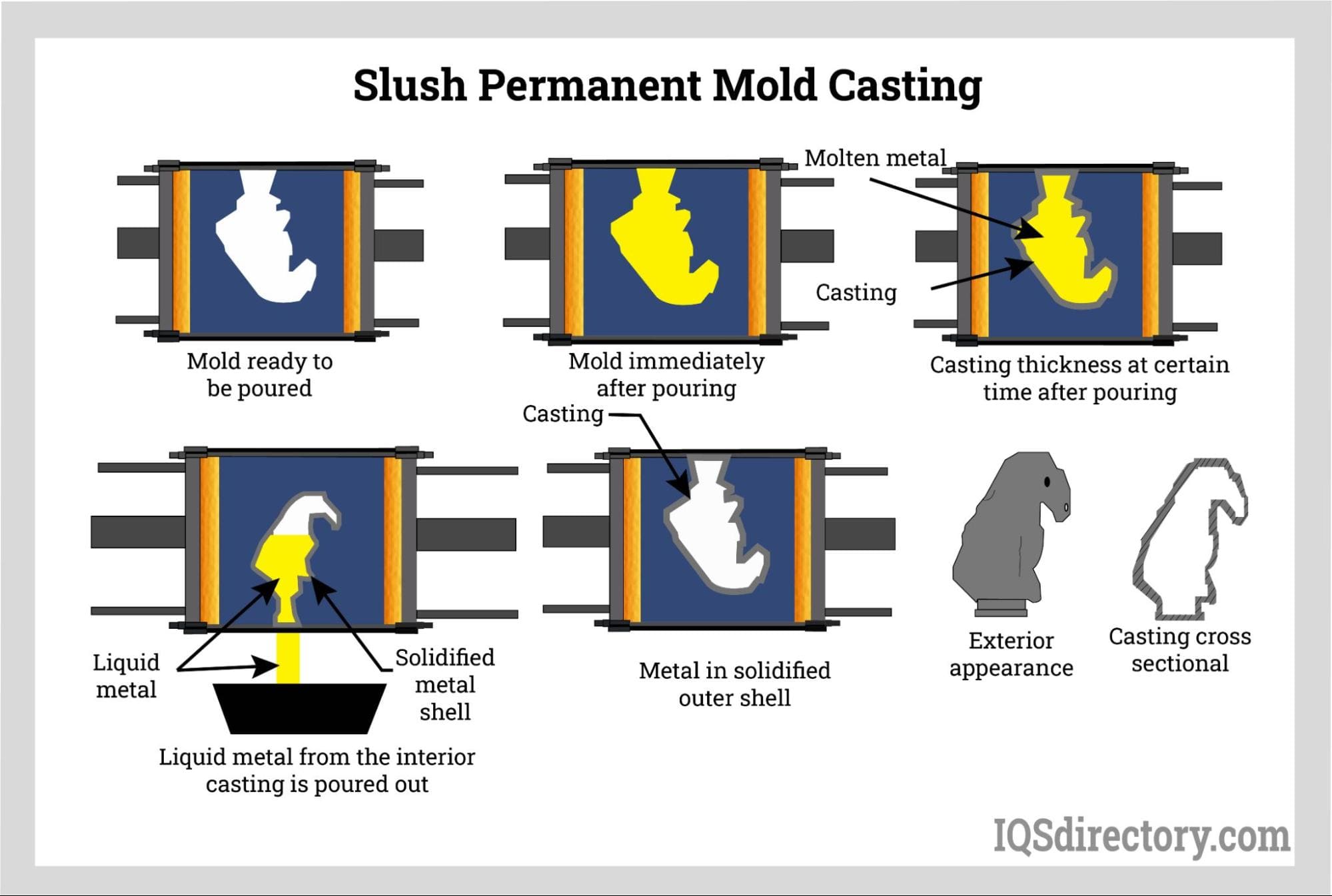
The core concept of slush casting hinges on the fact that the metal solidifies from the mold's walls inward. This means the outer layer, or the 'skin' of the mold, thickens and hardens first. In the slush casting process, once a solid outer shell forms within the mold, any unhardened molten metal inside is drained out. This leaves behind a hollow metal shell that takes on the shape and basic characteristics of the intended design. The duration the molten metal is kept in the mold before draining influences the thickness of this hollow part—the longer it remains, the thicker the walls of the casting become.
Conclusion
The world of permanent mold casting covers a wide range of processes, each with its unique advantages and applications. From the traditional gravity casting to the precision of vacuum casting, these techniques demonstrate the adaptability and efficiency of permanent mold casting in modern manufacturing.
The ability to produce durable, high-quality castings with fine surface finishes and tight tolerances makes permanent mold casting a valuable choice for industries ranging from automotive to aerospace, and many more.
If you're interested in exploring how permanent mold casting can benefit your project or if you want to begin connecting with permanent mold casting manufacturers, we encourage you to reach out to a few of our leading manufacturers for more information.